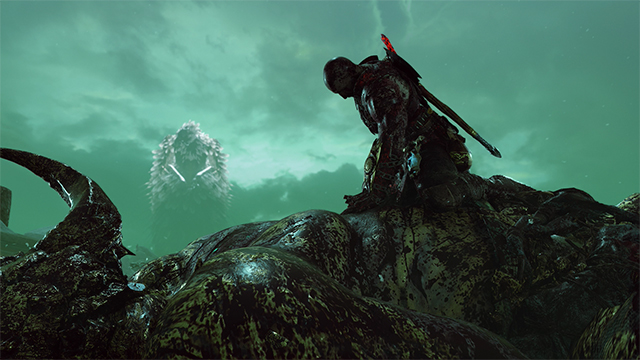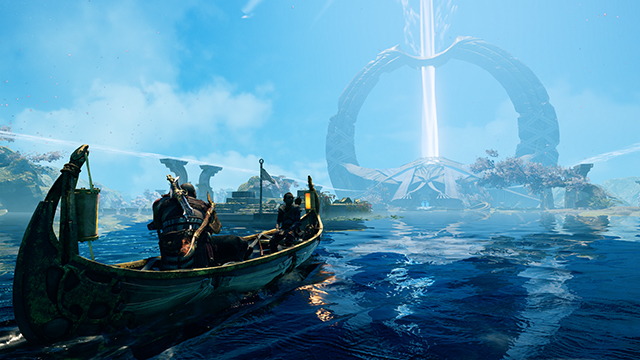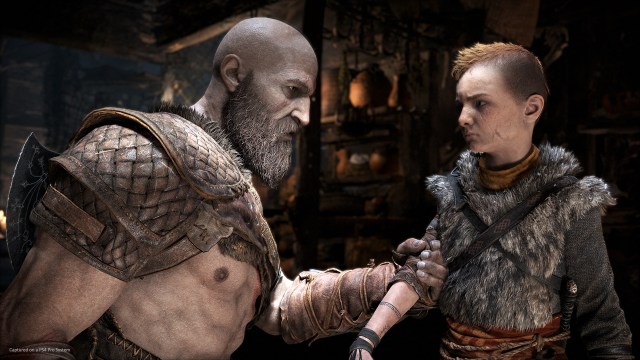To celebrate the one-year anniversary of God of War, we’ll be publishing (or republishing) some deep dives on how the Game of the Year winner came to be based on some GDC 2019 talks.
The no-cut camera was one of the most widely praised parts of God of War. It rewrote how we experienced the game’s story and gameplay. But it was just one part of the game’s approach to cinematography, a word not normally associated with video games. Sony Santa Monica wanted to create a cinematic experience that made players more emotionally involved but had to do so in a way not typically seen in the medium. It was a bold vision and in order to thoroughly execute it, the team had to think creatively to not only use cinematography in the traditional, cinematic ways to create empathy, but also in ways exclusive to the interactive medium.
Dori Arazi, director of photography at Sony Santa Monica, described this process of turning the game into a more an emotionally engaging interactive experience at GDC 2019. But this was pretty difficult since he argues that the constant barrage of media desensitizes audiences as everything is always vying for our emotions. Breaking through that barrier was going to be difficult since we only have so many emotions to spend.
Creating mental and emotional resonance in God of War

Arazi came up with a theory to break through the noise and have God of War stick out. By combining mental and emotional resonance, Arazi claimed he would try to grab players by the mind and heart; not separately but together.
Mentally grabbing players is found more typically in the gameplay part of a video game. Absorption, a key word for Arazi, makes players feel like they are really there and this usually happens through navigation, puzzles, and combat. All of these make players feel more mentally absorbed through their fingers.
The story, on the other hand, makes players feel more sympathetic. This is related to (but different from) empathy, which is where the player feels the character’s emotions as if they are that character. Sony Santa Monica tried to combine absorption and sympathy in order to create empathetic immersion, which is the “sense of truly ‘being there,’ both mentally and emotionally.”
The camera plays an important role in achieving empathetic immersion. Like in film, camera movements can evoke certain emotions and responses. For example, as Arazi pointed out, the first-person film Hardcore Henry is great for absorption (you feel there) but not for sympathy since the character never speaks. It’s jarring. A more traditionally shot film can get you to sympathize for the characters, but it isn’t as absorbing. You don’t feel like you’re there.
This became a problem for Arazi and the team since they wanted God of War to make players feel like they were there and also create sympathy. Both camera styles weren’t cutting it so the team decided the combine them in the “1.5 person camera.” Ideally, this would combine the empathy and absorption needed to evoke empathetic immersion. Although empathetic immersion is fragile and can be easy to drop but hard to pick back up, meaning that any minor stumble in this fantasy would make everything crumble.
A fantasy game taking inspiration from reality

But God of War has an intrinsic problem: it is a fantasy game and thus makes it harder to be absorbed. Relating to the source material is vital but hard once you add dragons and magic into the mix. To combat this, they scoured around for another visual language to get players more absorbed and began exploring documentary filmmaking. Documentaries are inherently real so shooting God of War like a documentary would help offset the flying axes and mythical Draugr walking around. In essence, absorption and being mentally engaged would go back up as the team would “trick” players’ brains into thinking it was more real (and more relatable) because of how it was shot.
Documentaries gave the team a few pillars to latch onto: a grounded camera, handheld shooting shooting style, naturalistic shot design, and naturalistic acting, and staging the character’s subjective experience. The grounded camera never did anything a real camera couldn’t. Handheld shooting reminds us of real-life cellphone footage we use almost everyday. Naturalistic shot design meant the game didn’t look as though it was shot on a soundstage. Naturalistic acting is similar in that the game moved away from the Shakespearean drama it was and used more grounded characters.
Staging the character’s subjective experience was a bit more nuanced since it required that the camera always be motivated by something in order to move. The camera didn’t move randomly, was but always compelled by tracking a motion or following someone’s eyeline. When the camera moves for a reason outside of the actors, it gives the sympathy to the camera operator, not the characters. God of War has this in its scenes as the camera moves fluidly as it follows the action and seamlessly transitions from shot to shot. It always has a reason tied to the characters which is important for relating to those characters.
Since Arazi explained that gameplay was more absorbing and cinematics were more sympathetic, Sony Santa Monica wanted to take it a step further by making gameplay more sympathetic and cinematics more absorbing. That was already a tough task that was made even tougher by its no-cut camera. Cuts are mentally jarring and not having them allowed a more seamless transition from absorbing gameplay to sympathetic cutscenes. But it also robbed them of the typical shot-reverse shot (A/B cuts), establishing shots, cuts between lenses, and more found in other media. Arazi compared it to writing a novel without using nouns or punctuation.
A/B cuts are arguably the most important since cutting back and forth between talking characters is one of the simplest ways to get viewers to see each person’s emotional response. This meant the team had to get clever in order to get that effect but without using that cutting technique.
For example, this scene shows Freya treating Atreus as the camera has to follow her to show what she is doing and then zoom out to show Kratos’ emotional response to the sick kid while displaying what Freya is doing. It’s complicated and likely not immediately noticeable to most people even if they do realize the emotional weight and result of the whole process. If players don’t notice how smooth it is and just the emotional weight of it, then the team has done its job.
Smooth transitions

Arazi didn’t just want to just combine sympathy and absorption either; he wanted to maintain that fusion which meant that its transitions needed to be flawless. Zooming in and out of combat or a cutscene was a big part of the game and was achieved in a few different ways.
Clever zooming was a good way to keep the experience smooth. Look at this scene from the E3 2016 reveal. If you notice, the move from Kratos to Atreus, the camera needs to move about 20 feet in just a second. In order to move that quickly, they zoomed the camera in while dollying the camera back so they could snap zoom back in as the camera jumps to Atreus.This allowed them to cover a lot of ground quickly without cutting.
These zooms had to be invisible as well so they could maintain immersion and they also helped hide lens changes. For example, this scene starts from a 24mm lens used for a wide shot and then changes to a 120mm lens to show the intimacy of Kratos mourning his wife. Kratos is moving too, which motivates and hides the zoom. Again, the player will feel this tight zoom without realizing it.
The team also had to make the game look worse to avoid the unimmersive qualities of falling into the uncanny valley. This included adding film grain, handheld camera work, stuff on the lens, lens flares, chromatic aberration, and missing focus. This calls back to the documentary style of filmmaking and maintaining a grounded, realistic feel since these kinds of flaws make the whole thing more realistic.
It’s the mostly unnoticed aspects of cinematography — like adding imperfections and hiding zooms— that can help a game establish a deeper emotional connection with the player. After all, cinematography goes far beyond the way the camera moves. While these big and small factors can be studied by those looking for it, they are mainly for there for people not to directly notice, but to feel.
Sony Santa Monica did just that by mentally engaging players through the gameplay and emotionally engaging them through the story, both of which worked together were enhanced by its carefully executed cinematic techniques. It may have taken many disparate groups within one large team to do it, but the results show how this attention to detail and sense of direction can create one of the medium’s most coveted narratives of the past decade.










